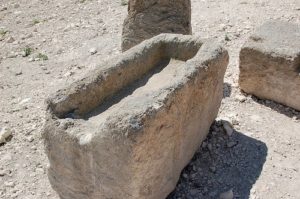[Greek] φάτνη (phatnē), [Latin] praesaepe, [French] mangier: feeding trough, manger, stall, crib, stable; Lk.2:7, Lk.2:12, Lk.2:16, Lk.13:15

A manger is essentially just an animal feeding trough.
Background information:
Greek Hellenism: This term means manger, crib, ease (comfort), courting one who feeds you, returning to one’s old haunts, and Manger (Praesaepe) in the star cluster in the Cancer constellation. This term has no specific religious sense. In addition to sheep, mangers are also used for horses, cattle, and donkeys. Sometimes mangers appear to be feeding places at temporary soldiers’ campsites. Greek mythology speaks of mangers or stalls, including Zeus’ horse Pegasus.
Homer’s Iliad 5.271: “And from these a stock of six horses born him in his palace, four he kept himself and reared in the stall, and the other two he gave to Aeneas.”
Homer’s Iliad 6.506: “Even as when a stalled horse that has fed his fill at the manger breaketh his halter and runneth stomping over the plain.”
Euripides’ Bacchae 510: “Shut him up near the horse stable, so that he may see only darkness.”
Strabo’s Geography 3.2.14: “One might guess too that it was on account of this great opulence that the men of the country, and their chiefs in particular, were styled long-lived.”
Homer’s Iliad 24.280: “And for Priam they led beneath the yoke horses that the old king kept for his own and reared in the polished stall.”
Galileo: “The nebula called Praesepe, which is not one star only, but a mass of more than forty small stars.”
Old Testament: This term means crib, manger, feeding trough, stall, and fodder. Interestingly, the measurements of a manger (drinking trough) were subject to the Sabbath requirements.
New Testament: This term is found three times in the nativity scene and one time when oxen are released from the mangers to be led out for watering. The manger emphasizes the contrast between the world-ruler Augustus and the hidden and lowly birth of the world-redeemer Jesus. Luke portrays the child Jesus outside the human dwelling place in an unusual place where there are only animals. This points to a story of humility and suffering. Many stone mangers were found at the time of Christ. Technically speaking, it was forbidden by the Sabbath law to lead the oxen out of the manger to be led out for watering. However, this practice was permitted out of practical necessity. The synagogue leader becomes indignant when Jesus heals a crippled woman on the Sabbath. Jesus points out their hypocrisy in not permitting healing or helping people on the Sabbath
Scripture;
“And she gave birth to her firstborn son. She wrapped Him in swaddling clothes and laid Him in a manger, because there was no room for them in the inn.” Lk. 2:7
Joseph found no vacancies at the travel lodge. The innkeeper had let Joseph and Mary take residence in the stable. In this specific situation, the legal term first-born, means the first child to “open the womb.”
“The Lord said to him in reply, ‘Hypocrites! Does not each one of you on the Sabbath untie his ox or his ass from the manger and lead it out for watering.’” Lk.13:15
Jesus just healed a crippled woman on the Sabbath, freeing her of her afflictions. However, the Jewish leaders were offended by what Jesus had done. Yet, the Sabbath laws allow the animals to be let out for watering. The Jewish leaders were hypocrites in that they cannot see that healing (or helping people) is more important than observing Sabbath rules.
Conclusion:
Manger
It was interesting to discover the less known meanings of this term, such as opulence, deferring to who feeds you, and returning to old haunts. Wealthy and influential individuals provided luxurious stalls for their animals. At first glance, I did not think the Latin meaning for of this term was important. I later discovered that this term is the name of the star cluster of the Beehive Nebula (swarm of stars).
I was surprised to learn that feeding stray animals was technically unlawful on the Sabbath. I was also surprised that the feeding troughs were subject to Sabbath rules and restrictions, yet these rules were relaxed for practical purposes. This provides an example of the Pharisees’ close-mindedness and misplaced priorities in helping others. Essentially, observing Sabbath laws were more important than healing (curing) people. An infant in swaddling clothes was a specific sign for the shepherds. For further information about swaddling clothes, please refer to my previous post: https://resoundingthefaith.com/2016/12/%e2%80%8egreek-%cf%83%cf%80%ce%b1%cf%81%ce%b3%ce%b1%ce%bd%cf%8c%cf%89-sparganoo-old-english-swaebian/
Like the shepherds and kings, we are looking for the infant away in the manger!
